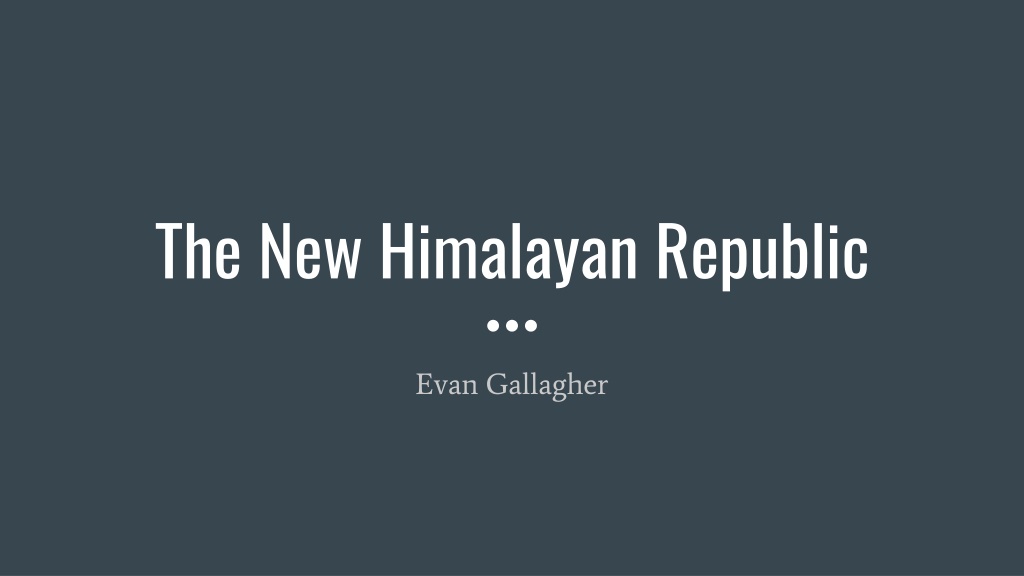Political Evolution of Nepal: From Monarchy to Republic
Explore the political history of Nepal from the days of monarchy to the establishment of a republic. Learn about the key players, structures, and societal makeup that have shaped the country's journey towards democracy and governance.
Download Presentation

Please find below an Image/Link to download the presentation.
The content on the website is provided AS IS for your information and personal use only. It may not be sold, licensed, or shared on other websites without obtaining consent from the author. Download presentation by click this link. If you encounter any issues during the download, it is possible that the publisher has removed the file from their server.
E N D
Presentation Transcript
The New Himalayan Republic Evan Gallagher
Main Players CPN-M (Communist Party of Nepal - Maoist) - Once listed as terrorist in many European countries but removed once they joined the Interim Government. ( due to the large role of overthrowing the king) Mainly supported by the rural population. CPN-UML (Communist Party of Nepal- Unified Marxist- Leninist) - Came into formation after the creation of Interim Government. NC ( Napali Congress) - Right leaning compared to the other two communist parties. Came into creation with Interim Government.
Modern Day Political Structure - Constituent assembly which included 240 First-Past-The-Post based system, 240 by proportional representation based on party lists, and 17 for eminences nominated by cabinet. Cannot exceed 25 Cabinet Members and are appointed by the President of Nepal. Heads of the country are the President and Prime Minister Judicial matters are decided by the Supreme court. - - -
Nepal's Make Up -28 million person population, 75% live in rural areas. - The upper classes are made up from Newars, Bahuns, and Chettris. Which controlled 75% cabinet seats and 61% of parliamentary seats. As Well as 90% of government positions. - 80% of the population practices Hinduism with the other 20% being a mixture of Buddhists, Shamanists, Animists, or other.
Post Colonial Nepal - - - - 1768: Prithvi Narayan Shah captures Kathmandu uniting Nepal. 1846: Pro British forces took over the country through a Palace Massacre. 1951: Power was once returned to the King through the Delhi compromise. 1960: King Mahendra used his emergency powers to dissolve Parliament and ban all political parties. Setting up a system where people could elect advisors to the king but this had no real effect than just to make the people think they had some say. 1980: Nationwide referendum to change the political structure was turned down but widely believed the whole voting process was rigged. -
Building of Opposition to the King - - - Original Caste began to weaken outside of the government. Banned parties went underground rallying support. Creations of separate Communist Parties of Nepal were created that defied the royal rule. (One of the only parties not outlawed was the CPN but many communist supporters didn t agree with their stance which created CPN-M, CPN- Unity Centre and CPN-ML) Armed Maoists in rural areas caused an uprising of wealthy landowners. -
First Jan Andolan - Nepal's increase in importing Chinese arms which somehow were later being smuggled into India, caused India to put a Blockade on Nepal which put strain on the rural areas of Nepal and resentment on the Royals Palace failure to resolve the Issue. People of Nepal were inspired by other successful overthrows throughout Europe. United Left front was formed made up of the CPN- Marxist and CPN-ML which started to hold large protests throughout the country. Protesters marched on the Palace and the Royal Army opened fire on them causing a Bloodbath. King was able to keep in control of the country and was able to maintain the Royal army. But lifted the ban on Parties and reestablished the congress Gaps in income from rich to poor widened. - - - - -
Aftermath of First Jan Andolan - Things were looking up since the congress had been reenacted and parties were no longer banned. But soon took a drastic turn. 2001: Crown Prince Dipendra murdered King Birendra along with the Queen and his brother and sister, then killed himself. Giving control over to King Birendra s Brother Gyanendra. Gyandendra almost immediately took emergency power which gave him control of the country and set out to destroy the Maoists. The Royal Nepal Swelled to 90,000 soldiers and spread out around the country. - - -
War - Maoist continued to operate their own underground government which was made up of 7 council members and backed by 10,000 trained guerrilla fighters, along with support from the People s Liberation Army which had nine brigades at its disposal. Furthermore had a militia that was 20,000 strong at their disposal. The king took precautions to eliminate all threats close to home by taking away power from the prime minister and other cabinet positions. -
Second Jan Andolan - - - 2006 Second Democratic Revolution ( Jan Andolan II) Declaration of a 4 day general strike and rally that turned into a 19 day uprising. Bringing over one million people to the streets of Kathmandu which eventually led the Royal Nepalese Army to enact a 18 hour shoot to kill order. Protesters were not stopped and led to cities to soon start to run out of food. King Gyanendra, on April 24, gave into the protesters after threats of a 2 million person march on his Palace . - -


























